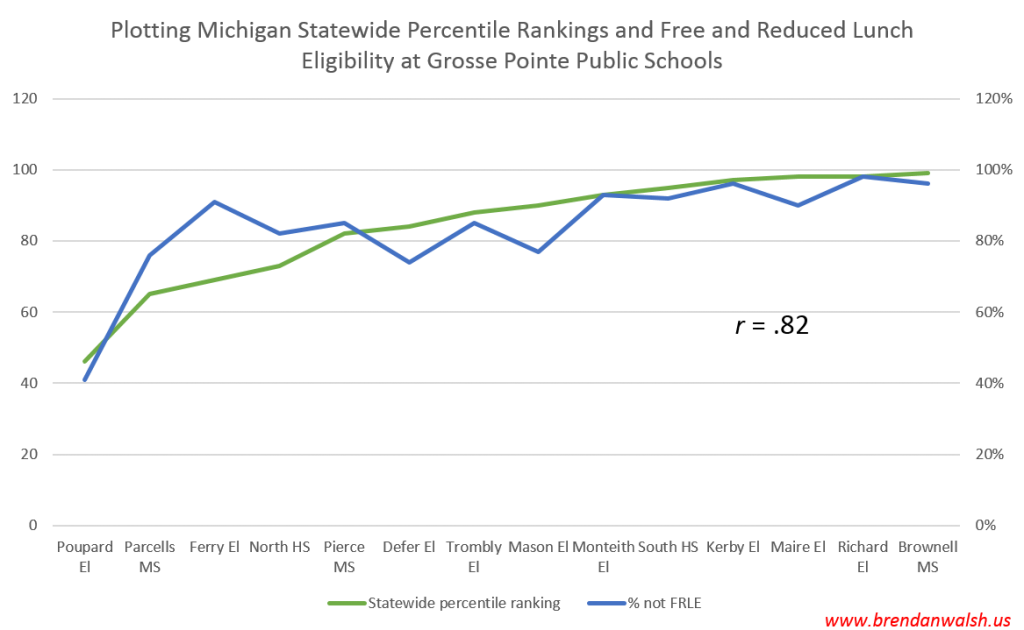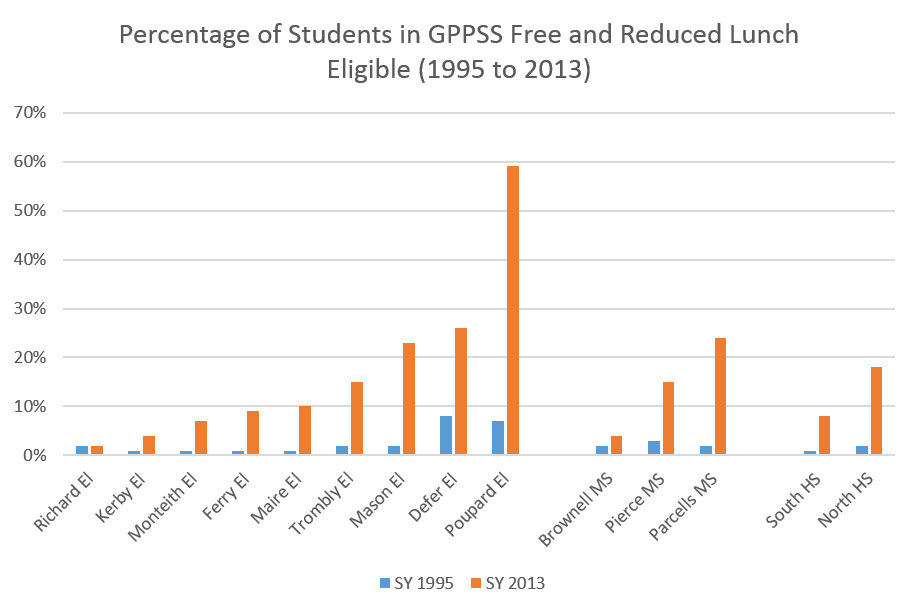The Department of Education released its annual Michigan school rankings and test results. Do we know what they mean or why – or even if – they matter?
The first chart below plots the statewide percentile ranking of each Grosse Pointe Public school against the percentage of students in each who are NOT Free and Reduced Lunch Eligible. By federal standards, a family of four is free lunch eligible when household income is below $29,965 and reduced lunch eligible below $42,643.
Statistically, the numbers show a strong positive correlation between lower enrollment in FRLE and state percentile rankings. (The “r” or correlation coefficient is a very high 0.82.) In other words, the wealthier the student population, the higher the state ranking. I have demonstrated before in a post back in September, 2010. It’s not materially different now.
Now look at the rise in percent of students Free and Reduced Lunch Eligibility by GPPSS school between 1995 and 2013.
In short, since state rankings correlate to wealth, school district rankings have dropped among the Grosse Pointe Public schools with rapidly rising FRLE populations or, in the case of South High School in particular, when certain government established “sub-groups” (e.g. African American, Economically Disadvantaged, Students with Disabilities) have become large enough to be scored separately.
It’s alluring to buy in or disregard, whole cloth, test score based measurements and rankings. The public and the district itself takes a selective stance on this. When scores and rankings are up, we seem to like them (see here). When they are down (like when North and South get a “red” ranking), we don’t like them so much. I’d link a press release on the red rankings, but I haven’t found one yet.
Certain segments of the public, and the public education establishment in particular, have long howled against No Child Left Behind (NCLB) legislation, which is why the state of Michigan tests and reports as they do. Sure, the far right has taken political advantage of NCLB to promote their own education agenda, but the far left is equally guilty by dismissing all test based measures of proficiency. We need to find a middle ground that puts the interests of students over politics. I’ve published opinions on this here and here.
The Grosse Pointe high schools’ rate red because neither are making enough progress for African American, Economically Disadvantaged, or students with disabilities. It’s disingenuous to toot our horn about how well the district’s least disadvantaged students perform and then decry the same measures when we don’t do as well among these other, equally important, segments of students.
Oh by the way, those are the growing student populations in the district – as the second chart above shows quite clearly.
This is when it gets hard.
As I reported last week, the Board of Education is about to establish parameters by which the superintendent will be measured. There could not be a more opportune time for the district to establish official positions on what measures matter and how to then link those to the efficacy of district leadership.
Without taking an official stance on how we will assess ourselves, how can we possibly make informed strategy and financial decisions?
The trite phrase applies: if we never declare where we are going we’ll never know if we get there.


3 responses to “Test scores, wealth and seeing red”
The release on the scores has been posted on the front page of the district website http://www.gpschools.org since Tuesday when the scores were unembargoed. Until then we were not petted to share info per the MDE. Please read and watch the board meeting tonight where we further explore.
Thanks for the reply, Rebecca.
The point of my post was that we tout the high scores we get from top students and then, usually, rationalize why not all students score that high. Years ago it was test calibration and scoring. This year it’s “not enough students took the test.”
We’re not alone as a district grappling with the Achievement Gap. It’s disingenuous, as some Board members are now writing, that the low test scores are solely attributable to not enough students taking the test. If that were true, we SHOULD be sending out press releases about how Grosse Pointe has solved the Achievement Gap problem. I doubt that’s the case.
The broader point was that the district’s plan should be linked to the district goals and superintendent evaluation. Also, as I’ve written before and referenced again here, identify other means of assessing the district. When I was on the Board I sponsored policies that obligated the district to annual surveys of students, parents, staff and the community. I’m not sure where those activities stand.
I also advocated for Common Assessments, which I see are listed on the State MDE site as “points of pride” for the district. I rarely, if ever, see these measures shared with the public.
Plenty of other options exist to communicate with the public and link these measures to district and superintendent goals.
The GPPSS press release has been posted since last week Tuesday when the scorecards were unembargoed. It is on the main page of the district website http://www.gpschools.org under Headlines. This was discussed at length at last night’s board meeting as well and that is available for viewing on Channel 20 or here: http://new.livestream.com/accounts/3685210/events/2355051/videos/28376184?origin=Digest&mixpanel_id=13c7db0ce0066-014c36fe-171f2e71-c0000-13c7db0ce02ce&acc_id=3741662&medium=email